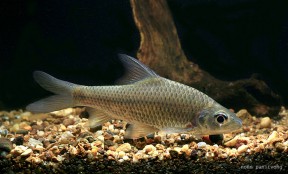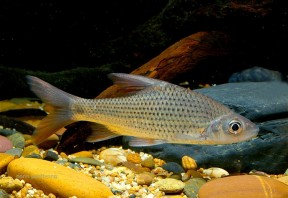Cyclocheilichthys armatus
SynonymsTop ↑
Barbus armatus Valenciennes, in Cuvier & Valenciennes, 1842; Barbus valenciennesii Bleeker, 1849; Capoeta enoplos Bleeker, 1851; Capoeta siaja Bleeker, 1851; Capoeta deventeri Bleeker, 1855; Cyclocheilichthys siaja Bleeker, 1860; Cyclocheilichthys macropus Bleeker, 1860; ? Barbus lineatus Popta, 1905; ? Barbus fowlerii Popta, 1906; Barbus dezwaani Weber & de Beaufort, 1912; Cyclocheilichthys tapiensis Smith, 1931; Cyclocheilichthys mekongensis Fowler, 1937; Cosmochilus nanlaensis Chen, He & He, 1992
Etymology
Cyclocheilichthys: from the Ancient Greek κύκλος (kýklos), meaning ‘circle’, χείλος (cheílos), meaning ‘lip’, and ἰχθύς (ikhthús), meaning ‘fish’, possibly in reference to the continuous lips in this genus.
armatus: from the Latin armatus, meaning ‘armed’, in reference to the strongly-ossified first dorsal-fin spine.
Classification
Order: Cypriniformes Family: Cyprinidae
Distribution
Currently understood to have an enormous natural range extending southwestwards from the Mekong region in Laos, Cambodia, and Vietnam through Thailand, Peninsular Malaysia and the Greater Sunda Islands of Borneo, Sumatra, and Java, with additional records from the Philippines.
It thus occurs throughout the Mekong, Mae Klong and Chao Phraya river drainages as well as a host of smaller river basins, lakes and reservoirs. It is used as a food fish in some countries and may vary a little in colouration and patterning depending on collection locality. The precise extent to which it’s been artificially-introduced across this range is unclear.
Habitat
A riverine species exhibiting mid-water to benthic foraging behaviour during the dry season, and is thought to migrate to flooded riparian forests during the wet season in order to reproduce.
It’s increasingly found in artificial water bodies such as reservoirs as a result of human interference and may also have been impacted due to damming, pollution or overfishing in some areas.
Maximum Standard Length
150 – 230 mm.
Aquarium SizeTop ↑
An aquarium with base measurements of at least 180 ∗ 60 cm will be required for long-term care.
Maintenance
Likely to thrive in many larger set-ups provided the water is scrupulously clean and well-oxygenated, although completely bare arrangements are best-avoided.
Water Conditions
Temperature: 20 – 26 °C
pH: 6.0 – 8.0
Hardness: 36 – 268 ppm
Diet
In nature this species primarily preys on small items including insects, insect larvae, crustaceans and the fry of other fish. For it to develop the best condition in the aquarium offer regular meals of small live and frozen foods such as chironomid larvae (bloodworm), Daphnia and Artemia along with good quality dried flakes and granules.
Behaviour and CompatibilityTop ↑
An ideal resident of the larger, well-furnished community set-up though large adults may intimidate slow-moving or particularly timid companions. There are plenty of suitable tankmates, however, including many cyprinids, loaches, cichlids, catfish and characins.
It is a gregarious species by nature and ideally should be kept in a group of at least six. The fish display better colouration in the presence of conspecifics, are less nervous and the display on the whole will appear more natural-looking.
Sexual Dimorphism
Sexually mature females are likely to be thicker-bodied than males.
Reproduction
Not thought to have been bred in aquaria to date. In nature it spawns in flooded zones towards the end of the wet season.
NotesTop ↑
As with others in the genus little has been written regarding this species’ captive care but it makes a peaceful and unusual addition to larger aquaria. The best way of obtaining it may be to keep an eye on shipments of wild fishes from Indochina and the Greater Sunda Islands as it’s rarely imported in large numbers and most often arrives as bycatch.
It can be distinguished from congeners by possessing one or two pairs of barbels, a black blotch at the base of the caudal-fin, and rows of dark spots along the lateral scale rows.
Members of Cyclocheilichthys are characterised by possessing a serrated dorsal fin spine, 9 branched pelvic fin rays, a conical snout, small, subterminal mouth and parallel rows of sensory folds on the snout and cheeks. The latter feature is lacking in most other cyprinids but present in a few genera including Eirmotus, Oreichthys, and Neobarynotus.
There have been some nomenclatural issues in recent years, ostensibly because Cyclocheilichthys and the now synonymous Anematichthys were used simultaneously by Bleeker (1859) in reference to the same fish, C. apogon. The issue was addressed by Kottelat (1999) but later misinterpreted by Pasco-Viel, Veran and Variot, 2012, who concluded that Cyclocheilichthys represents a paraphyletic grouping and split the genus into two groups: Cyclocheilichthys (comprising C. enoplos) and Anematichthys (comprising C. apogon, C. armatus and C. repasson).
This was corrected by Kottelat (2013), and Cyclocheilichthys currently comprises seven species with the revalidated genus Cyclocheilos including the former members C. enoplos and C. furcatus. C. heteronema differs considerably from other Cyclocheilichthys species and may eventually be separated with the generic name Oxybarbus available for it.
Given the extremely wide range exhibited by C. apogon, and taking into account patterns observed in other Southeast Asian fishes, it seems logical that this species may also turn out to represent a group of closely-related taxa.
References
- Valenciennes, in Cuvier & Valenciennes, 1842 - Histoire naturelle des poissons v. 16: i-xx + 1-472
Histoire naturelle des poissons. Tome seizième. Livre dix-huitième. Les Cyprinoïdes. - Cervancia, M. and M. Kottelat, 2007 - Raffles Bulletin of Zoology 55(1): 141-145
Cyclocheilichthys schoppeae, a new species of freshwater fish (Teleostei: Cyprinidae) from northern Palawan, Philippines. - Freyhof, J., D. V. Serov, and T. N. Nguyen, 2000 - Bonner Zoologische Beiträge 49(1-4): 93-99
A preliminary checklist of the freshwater fishes of the River Dong Nai, South Vietnam. - Kottelat, M., 1999 - Raffles Bulletin of Zoology 47(2): 591-600
Nomenclature of the genera Barbodes, Cyclocheilichthys, Rasbora and Chonerhinos (Teleostei: Cyprinidae and Tetraodontidae), with comments on the definition of the first reviser. - Kottelat, M., 2001 - WHT Publications, Colombo: 1-198
Fishes of Laos. - Kottelat, M., 2013a - Zootaxa 3640(4): 479-482
The valid generic names for the fish species usually placed in Cyclocheilichthys (Pisces: Cyprinidae). - Kottelat, M., 2013b - Raffles Bulletin of Zoology Supplement 27: 1-663
The fishes of the inland waters of southeast Asia: a catalogue and core bibiography of the fishes known to occur in freshwaters, mangroves and estuaries. - Kottelat, M. and E. Widjanarti, 2005 - Raffles Bulletin of Zoology Supplement 13: 139-173
The fishes of Danau Sentarum National Park and the Kapuas Lakes area, Kalimantan Barat, Indonesia. - Ng, H. H. and H.-H. Tan, 1999 - Zoological Studies 38(3): 350-366
The fishes of the Endau drainage, Peninsular Malaysia with descriptions of two new species of catfishes (Teleostei: Akysidae, Bagridae). - Parenti, L. R. and K. K. P. Lim, 2005 - Raffles Bulletin of Zoology Supplement 13: 175-208
Fishes of the Rajang Basin, Sarawak, Malaysia. - Pasco-Viel, E., M. Veran and L. Variot , 2012 - Zootaxa 3586: 41-54
Bleeker was right: Revision of the genus Cyclocheilichthys (Bleeker 1859) and resurrection of the genus Anematichthys (Bleeker 1859), based on morphological and molecular data of Southeast Asian Cyprininae (Teleostei, Cypriniformes). - Pasco-Viel, E., M. Veran and L. Variot , 2013 - Zootaxa 3640(3): 483-484
Comments on 'The valid generic names for the fish species usually placed in Cyclocheilichthys' (KOTTELAT 2013) and a correction of Pasco-viel et al. (2012). - Rainboth, W. J., 1996 - FAO, Rome: 1-265
Fishes of the Cambodian Mekong. FAO Species Identification Field Guide for Fishery Purposes.



